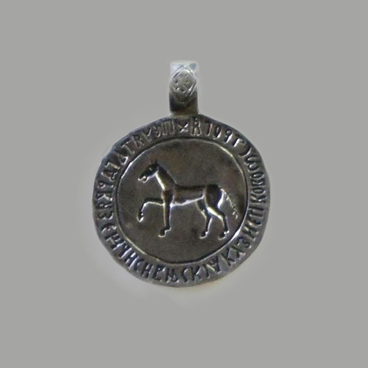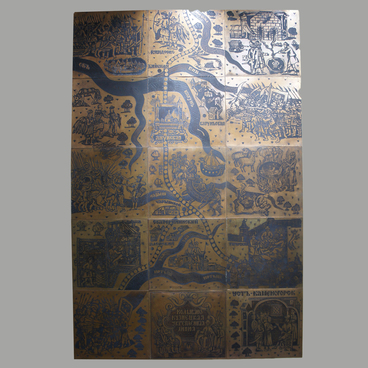In his picture Kuznetsk Wedding Crown, Kemerovo graphic and portrait artist German Zakharov portrayed Fyodor Dostoyevsky and his first wife Maria, née Konstant.
Her contemporaries described Maria as ‘a nice-looking blonde, medium tall, very thin, passionate and gushing… well read, rather educated, curious, kind, and unusually lively and impressionable’. At the age of 22, she married Alexander Isayev, a customs officer, and soon gave birth to a son, Pavel.
The Isayevs moved often. In the 1850’s, they changed several addresses in different cities and settled in Semipalatinsk. They were destitute there. At the start of his customs service, Isayev was an excellent officer expected to push his fortune quickly, but he took to drinking, often conflicted with his seniors, and eventually lost his job and hit the skids.
In 1854, the Isayevs met Dostoyevsky, who had come to work in Semipalatinsk. The writer fell in love with Maria. “This lady, still young, 28 years of age, is pretty, very educated, very smart, kind, sweet, graceful, and has a pluperfect, generous heart, ” he wrote about Maria. However, she remained indifferent to her suitor”s ardent feelings.
A year later, the Isayevs moved to Kuznetsk. For months, Dostoyevsky exchanged letters with her ladylove, “sobbed like a child”, and soon received a letter where she notified him of her husband’s death. The writer immediately proposed to her, but didn’t get an answer: in Kuznetsk, Maria got infatuated with Nikolay Vergunov, who gave French lessons to her and drawing lessons to her son. Dostoyevsky’s acquaintances recalled that, when he received Isayeva’s letters telling him about her new friend, the writer “suffered from jealousy, it was scaring to see him in a gloomy mood”.
But in the end, Isayeva consented to marry Dostoyevsky. In 1857, the wedding took place in the Hodigitria Church in Kuznetsk, where Dostoyevsky had arrived for a holiday after he borrowed a considerable amount of money for the marriage from his friends and colleagues.
Soon, Dostoyevsky’s marriage happiness was clouded by health problems. When the newly-weds were coming back to Semipalatinsk the writer had an epileptic attack. He recalled: ‘As I was preparing for marriage I totally believed doctors, who assured it was just fits of nerves, which were going to disappear when my life changed. If I had surely known I was suffering from real epilepsy I wouldn’t have got married.’
Fyodor’s and Maria’s married life did not last long. Dostoyevsky often travelled while his wife rarely accompanied him. In the 1860’s, she caught tuberculosis. Her husband brought Maria from city to city, showed her to lots of doctors, but the young lady was fading away quickly and in 1864 died with Dostoyevsky at her side.
Her contemporaries described Maria as ‘a nice-looking blonde, medium tall, very thin, passionate and gushing… well read, rather educated, curious, kind, and unusually lively and impressionable’. At the age of 22, she married Alexander Isayev, a customs officer, and soon gave birth to a son, Pavel.
The Isayevs moved often. In the 1850’s, they changed several addresses in different cities and settled in Semipalatinsk. They were destitute there. At the start of his customs service, Isayev was an excellent officer expected to push his fortune quickly, but he took to drinking, often conflicted with his seniors, and eventually lost his job and hit the skids.
In 1854, the Isayevs met Dostoyevsky, who had come to work in Semipalatinsk. The writer fell in love with Maria. “This lady, still young, 28 years of age, is pretty, very educated, very smart, kind, sweet, graceful, and has a pluperfect, generous heart, ” he wrote about Maria. However, she remained indifferent to her suitor”s ardent feelings.
A year later, the Isayevs moved to Kuznetsk. For months, Dostoyevsky exchanged letters with her ladylove, “sobbed like a child”, and soon received a letter where she notified him of her husband’s death. The writer immediately proposed to her, but didn’t get an answer: in Kuznetsk, Maria got infatuated with Nikolay Vergunov, who gave French lessons to her and drawing lessons to her son. Dostoyevsky’s acquaintances recalled that, when he received Isayeva’s letters telling him about her new friend, the writer “suffered from jealousy, it was scaring to see him in a gloomy mood”.
But in the end, Isayeva consented to marry Dostoyevsky. In 1857, the wedding took place in the Hodigitria Church in Kuznetsk, where Dostoyevsky had arrived for a holiday after he borrowed a considerable amount of money for the marriage from his friends and colleagues.
Soon, Dostoyevsky’s marriage happiness was clouded by health problems. When the newly-weds were coming back to Semipalatinsk the writer had an epileptic attack. He recalled: ‘As I was preparing for marriage I totally believed doctors, who assured it was just fits of nerves, which were going to disappear when my life changed. If I had surely known I was suffering from real epilepsy I wouldn’t have got married.’
Fyodor’s and Maria’s married life did not last long. Dostoyevsky often travelled while his wife rarely accompanied him. In the 1860’s, she caught tuberculosis. Her husband brought Maria from city to city, showed her to lots of doctors, but the young lady was fading away quickly and in 1864 died with Dostoyevsky at her side.

